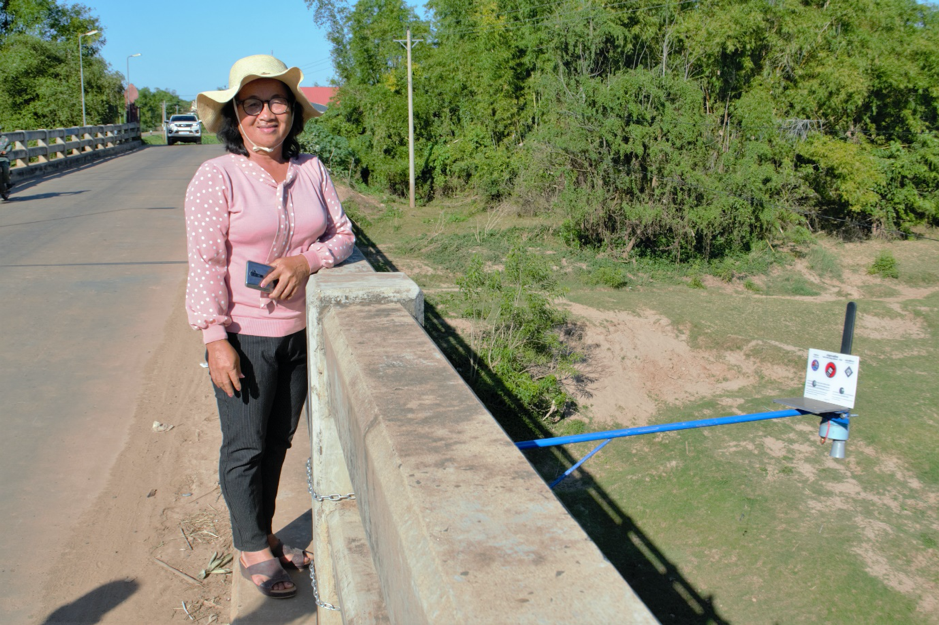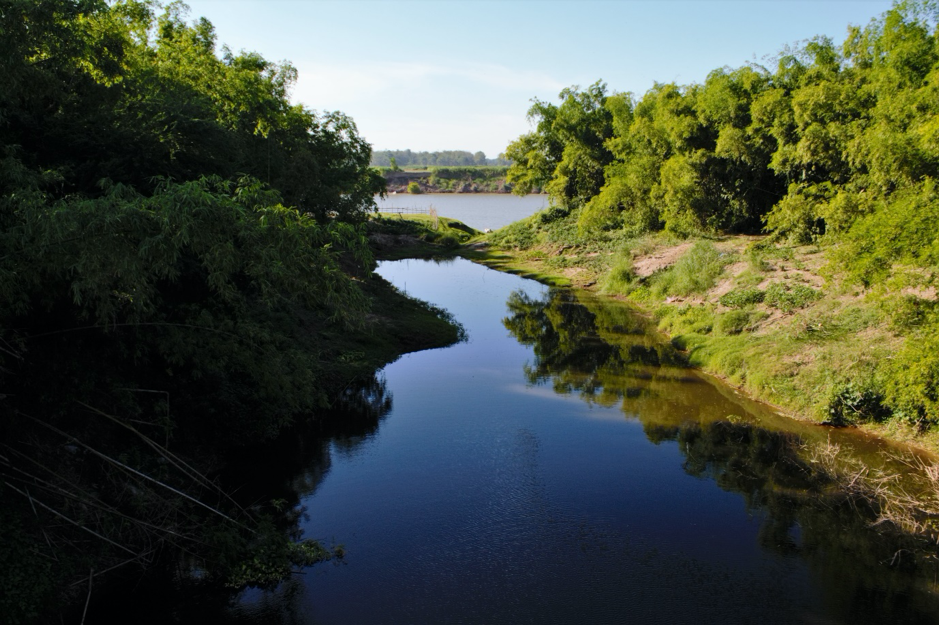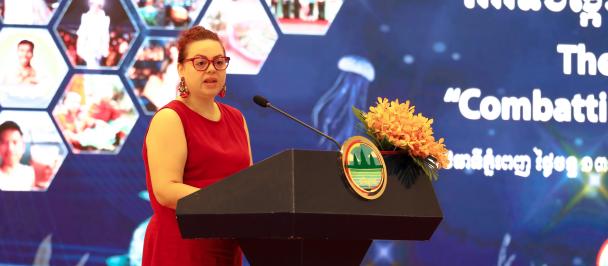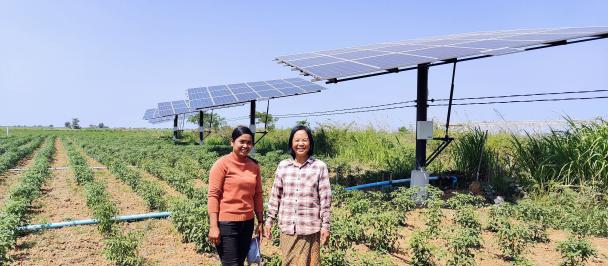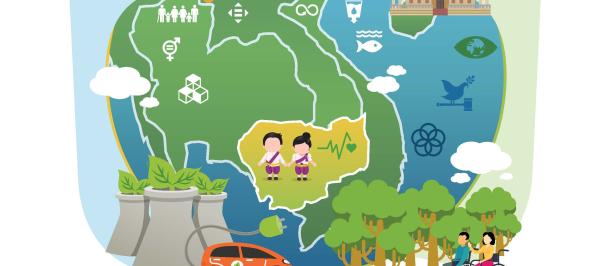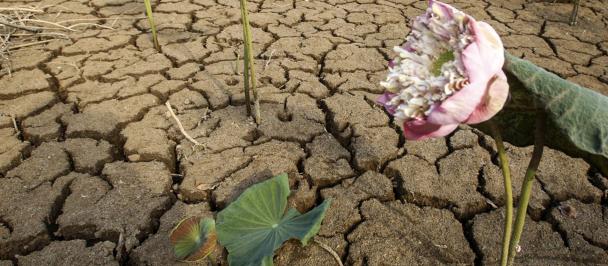Members of the Tuol Dambang village with their new safe site. Photo credit: UNDP Cambodia/Kelsea Clingeleffer
December 2019, Tboung Khmum - It is now the end of 2019 and the year is ending on a happy note for residents of Tuol Dambang village. Yet only a few months ago, community members were worried.
Life in Tuol Dambang, located in Boeng Pruol commune, Tboung Khmum province, revolves around the river which runs through it. Every day, farmers traverse the waterways to nearby villages to purchase feed for their animals. Agricultural crops such as corn and rice depend on water and farmers rely on regular annual river flooding to feed their fields.
In August, the regular flooding which traditionally occurs had not yet arrived (see the article here). The community was worried – a lack of rain can make raising both crops and livestock challenging.
“Normally the flood comes around August. This year it came in October and only for a short time (about 2 weeks); in other years, it has come for at least one month. This caused issues because there is a kind of insect that eats the crops. The floods can’t kill these insects if it is too short, so now we still have the insects. Also, when the flood is gone, the ground will be wet but if the flood is too short, the ground dries quicker and it is harder to water our fields,” said commune chief, Mrs. Try Teang.
While people were worried, this year was the first time that Tuol Dambang has had access to new early warning systems and safe site infrastructure.
In order to assist the community in managing both the positive and negative impacts of natural hazards, People in Need (PIN) Cambodia partnered under the United Nations Development Programme (UNDP)-supported project, ‘Strengthening Climate Information and Early Warning Systems in Cambodia’ funded by GEF-Least Developed Countries Fund.
The partnership facilitated the expansion of the Early Warning System (EWS) 1294, a phone-based alert system, as well as installation of water sensors which support more accurate forecasting and warning of impending crisis events.
Commune chief Mrs. Try Teang with one of the newly installed water sensors, which will support more accurate flood forecasting and warning. Photo credit: UNDP Cambodia/Kelsea Clingeleffer.
What does a community’s experience look like after an early warning system has been implemented?
Previously, community members used traditional methods to determine when a flood was coming including listening for the sounds of frogs or simply waiting for water to arrive under their homes – a challenge in an increasingly unpredictable climate.
Introduction of EWS 1294 – which issues an audio message to subscribers’ mobile phones ahead of a disaster – supports more effective early warning by increasing the public’s capacity to prepare and take action ahead of adverse weather. The ability to proactively plan and mitigate risks is an important component of early warning systems such as those found in Tboung Khmum commune.
In August and September 2019, 17,634 people were alerted to critical events using EWS 1294 in Tboung Khmum province alone.
Mrs. Teang commented on how positive having access to EWS 1294 makes her commune members feel: “They came to me to tell me it was such a good thing because they get the early warning before the flood arrived! It was sent by the provincial committee. It could alert them in advance of the disaster and help them to prepare before the risk happened.”
Village chief Mr. Noun Vuthy also highlighted the value of enhanced early warning, “This year we were informed by the EWS 1294 system. This is important because every day we have to go to another village by boat to get grass for the cows – the alert helps us know whether we should go or not (we cannot go if it is too windy or during a flood or storm), and if we have to find food elsewhere.”
Waterways play an important role in the Tuol Dambang village, meaning that early warning systems for flooding events are crucial. Photo credit: UNDP Cambodia/Kelsea Clingeleffer.
As well as facilitating access to EWS 1294, the partnership between People in Need and UNDP also resulted in construction of safe site infrastructure in Tuol Dambang.
“Having a building on the safe site cannot help solve everything, but it is an important part of the solution. It means that the livestock can be kept outside, and the people stay under the shelter, and they have clean toilets to use. As a result, everything is cleaner,” said Mr. Vuthy.
An estimated 200 families use the safe site during the floods, as well as providing a safe location for 600 to 800 cows. Ms. Soun Somaly, a member of the village, said, “I am very happy that we have the shelter. It helps to protect us when it rains and storms, we can sit around together, and it makes us feel safe.”
Written by Kelsea Clingeleffer, International Results Monitoring Consultant
For more information contact Muhibuddin Usamah (Project Manager) at muhibuddin.usamah@undp.org

 Locations
Locations
